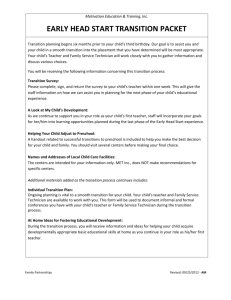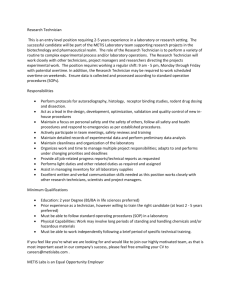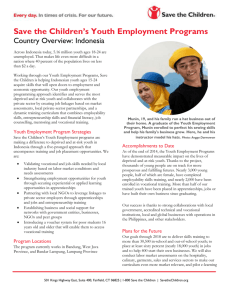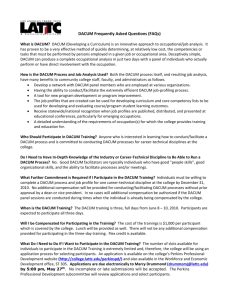View paper
advertisement
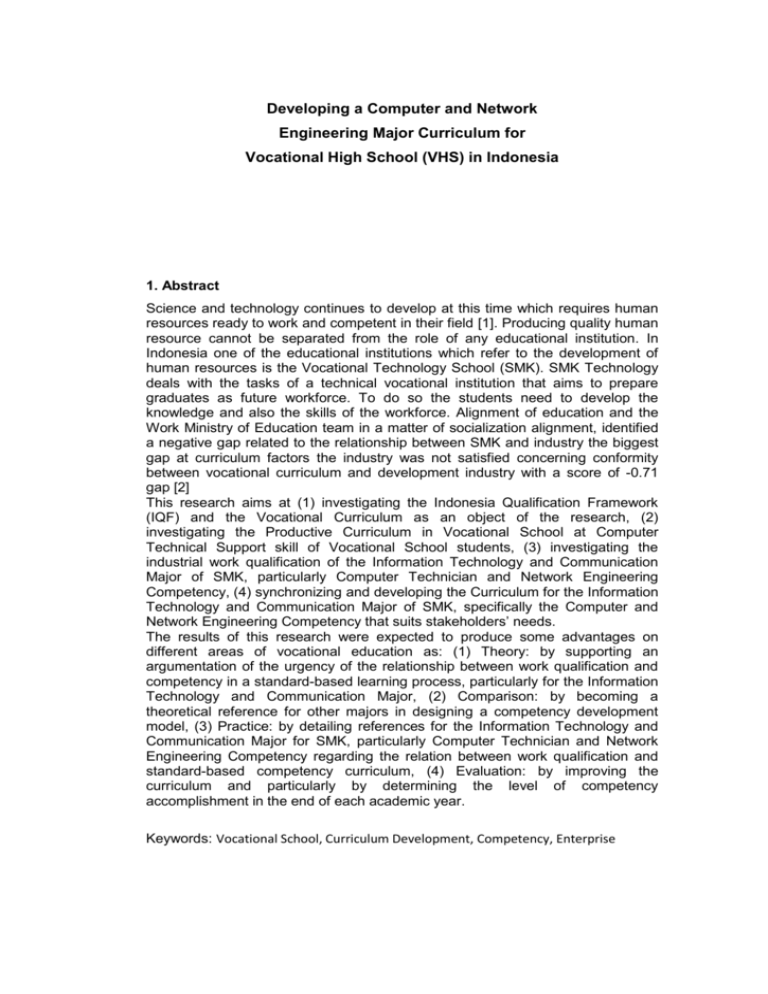
Developing a Computer and Network Engineering Major Curriculum for Vocational High School (VHS) in Indonesia 1. Abstract Science and technology continues to develop at this time which requires human resources ready to work and competent in their field [1]. Producing quality human resource cannot be separated from the role of any educational institution. In Indonesia one of the educational institutions which refer to the development of human resources is the Vocational Technology School (SMK). SMK Technology deals with the tasks of a technical vocational institution that aims to prepare graduates as future workforce. To do so the students need to develop the knowledge and also the skills of the workforce. Alignment of education and the Work Ministry of Education team in a matter of socialization alignment, identified a negative gap related to the relationship between SMK and industry the biggest gap at curriculum factors the industry was not satisfied concerning conformity between vocational curriculum and development industry with a score of -0.71 gap [2] This research aims at (1) investigating the Indonesia Qualification Framework (IQF) and the Vocational Curriculum as an object of the research, (2) investigating the Productive Curriculum in Vocational School at Computer Technical Support skill of Vocational School students, (3) investigating the industrial work qualification of the Information Technology and Communication Major of SMK, particularly Computer Technician and Network Engineering Competency, (4) synchronizing and developing the Curriculum for the Information Technology and Communication Major of SMK, specifically the Computer and Network Engineering Competency that suits stakeholders’ needs. The results of this research were expected to produce some advantages on different areas of vocational education as: (1) Theory: by supporting an argumentation of the urgency of the relationship between work qualification and competency in a standard-based learning process, particularly for the Information Technology and Communication Major, (2) Comparison: by becoming a theoretical reference for other majors in designing a competency development model, (3) Practice: by detailing references for the Information Technology and Communication Major for SMK, particularly Computer Technician and Network Engineering Competency regarding the relation between work qualification and standard-based competency curriculum, (4) Evaluation: by improving the curriculum and particularly by determining the level of competency accomplishment in the end of each academic year. Keywords: Vocational School, Curriculum Development, Competency, Enterprise 2. Introduction and Research Context The ability to empower and manage Human Resources in science and technology is the key to a nation's victory in the era of globalization. For a nation, globalization is an opportunity and a challenge as well. Globalization can accelerate the pace of development: the relationship between regions, provinces and countries can be done quickly and without borders (borderless), but on the other hand with the globalization competition will be tighter and sharper, other countries competing for the own opportunity. Major force in winning the global competition is the competitive advantage of the products and services produced. The key for gaining competitive advantage is fostering the competitiveness of the human resources. Improving the quality of human resources cannot be separated from the quality of education that belongs to a countries culture. By that education is one of the strategic factors in improving the quality of human resources. Prosser (1979) outlined the principles relating to the vocational education with industry that as (a) vocational education will be efficient if the environment in which students are trained is a replica environment where they would work; (b) an effective vocational education can only be granted where the exercises are done in a way with the same tools and machinery as stipulated in the workplace; (c) vocational education will be effective if a person is trained in the habit of thinking and work as required in the work itself. This is certainly not easy to be realized and requires close cooperation between schools and industry to produce graduates who have the ability (skills) accepted by the labor market. Unpreparedness of graduates from the Vocational High School (VHS) toward working in industry has a domino effect on the industrial stakeholder, because industry must provide suitable training itself to prepare its workforce. Thus the industry should allocate extra costs beyond the cost of production (Pardjono, 2011). The Indonesian Ministry of Education and Culture has issued a series of policies oriented to the improvement of competency standards at every level of the educational unit. Competency-based curriculum in Indonesia was born as the implications of the Act No. 22 of 1999 on Regional Government and Government Regulation No. 25 of 2000 on the authority of the Government and the Provinces as Autonomous Regions. With the Act, then a change in the education policy of the management is centralized to decentralize. The policy change, of course, has implications for curriculum improvement; the area was given the freedom to develop the education sector in the region based on the characteristics of the area. As one of the result of decentralization in education, curriculum based competence as the direction in order to truly fit the needs of the development potential of the learners at the school taking into account the local interests, national and global demands. Due to the Strategic Plan of the Indonesian Ministry of National Education in for 2010 - 2014 the educational outcomes should meet the needs of business and industry in order of the alignment of education and the needs of the business and industrial world. Education unconformity with industry will by a team of the Ministry of National Education in the alignment of the compilation report results of a pilot project in 2011 (2012) caused by (1) the gap between the number of graduates by the number of needs of the workforce, (2) competency gap with the workforce competencies required, (3) the area is not able to absorb graduates from the local site, not available graduates required a region, (4 ) changes in conditions (economic) concerning local and national and global education. Based on the result of research in 2010 by the Indonesian alignment who has conducted a tracer study of the graduates who have worked in the industry based on a 4dimensional alignment (quantity, competence, location, and time), meanwhile, conducted a series of comprehensive surveys to determine the level of satisfaction of the workforce on the quality of graduates and the performance of institutions, as well as the level of graduate satisfaction on the performance of the institution and the treatment of the working world. The survey results were analyzed through gap analysis, Kruskall Wallis test, mean test (average), and regression analysis was identify any negative gap relates to the relationship between vocational schools with the industry is a gap factors are (1) a cooperative relationship with industry showing a gap of -0.30 (2) coordinating the evaluation and joint curriculum development between educational institutions with industry have a gap -0.26, (3) the duration of the education program, has a gap of -0.29 (4) compliance with the curriculum development of the industry has a gap 0.71, (5) the accuracy content of teaching material between hard skills and soft skills portion, has gap -0.59, (6) the time available to industry practice, has gap 0.45, (7) evaluation of the results of work done at the same practice among the educational institutions with industry as the place to practice, have a gap -0.57. Based on the above data the biggest gap between vocational sector and industry in vocational training is on the curriculum factors, industry was not satisfied with the conformity of vocational high school with the industrial development with a score of -0.71 gaps. Referring to the various things that the author implicitly described before it can be said that the curriculum in the Vocational High School (VHS) does especially in computer technician and computer network does not meet industry expectations. Therefore, it is necessary to encourage the vocational sector and the industry to jointly develop education having graduates aligning their skills competitively and meeting the requirements of the industry. For identify computer technician and computer network work and skills in the broad ICT business area, a common model structure of ICT business and work areas, fields of activities and ICT work tasks has been designed – the so called GAHFA (named after the original German meaning “Geschäftsprozess – Arbeitsprozesse – Handlungs-Felder – Arbeitsaufgaben”; cp. Petersen, 2004) 3. Literature Review 3.1. Curriculum According to Finch & Crunklinton (1979) a curriculum is a collection of activities and learning experiences to be experienced by a group of students under the direction and responsibility of a school. Curriculum is a set of plans and arrangements regarding the objectives, content and learning materials and methods used to guide the implementation of learning activities to achieve specific educational objectives (Act No. 20 of 2003, Government Regulation No. 19 of 2005). Caswell and Campbell (William F.Pinar, 2008): curriculum is composed of all of the experiences children have under the guidance of the teacher. Deutscher Bildungsrat (Cedefop, 2010b) describe curriculum as the concept is related to the learner, it is sometimes also used as a third meaning, as an equivalent of the school career of a pupil or the apprenticeship of a trainee. In that sense, the concept describes an individual course of study in its totality as one unit. 3.2. Curriculum Development Curriculum development refers to the processes by which curriculum documents are generated and then implemented. As is subsequently demonstrated, it is helpful to imagine these processes as collectively forming part of a larger mission and, accordingly, to conceptualize the curriculum not only in terms of its function as a written document but also in terms of how it is created. This emphasis on the process can help to understand how outcome-oriented approaches are developing over time and between countries. (Cedefop, 2012) Curriculum development focuses on the procedures and stakeholder roles that lead to curricula documents taking their form. Just as significant for the form and function of the curriculum is who is involved and how. For example, curriculum documentation in one country may systematically exclude any explicit pedagogical guidance; however, such guidance may be provided through official sources such as the schools inspectorate or teachers’ handbooks. The important point, in such cases, is not the documentary form that such prescriptions take but who is doing the prescribing and according to what criteria. (Cedefop, 2012) The process of curriculum development can be seen as narrow (developing a curricular product) or broad (comprehensive and ongoing improvement). In order to successfully address tasks of curriculum decision-making and enactment, a broader description of curriculum development is often most appropriate: usually a long and cyclic process with many stakeholders and participants, in which motives and needs for changing the curriculum are formulated, ideas are specified in programs and materials, and efforts are made to realize the intended changes in practice. (Van den Akker, 2010) 3.3 Indonesia Qualification Framework (IQF) IQF is a framework of a level of competency qualification that enables to equalize, harmonize and integrate between formal education, vocational training & education and working experiences in rewarding or recognizing workcompetency in line with the job structure in each sector (Regulation, 2012) 3.4 European Qualification Framework (EQF) The European Qualifications Framework for lifelong learning (EQF) provides a Europe-wide common reference framework which assists in comparing the national qualifications systems, frameworks and their levels. It serves as a translation device to make qualifications more readable and understandable across different countries and systems in Europe, and thus promote lifelong and life-wide learning, and the mobility of European citizens whether for studying or working abroad. (European Commision, 2013) 3.5 DACUM (Developing Curriculum) DACUM is an acronym which stands for Developing A CurriculUM as used widely today is a unique, innovative, and very effective methode of job and/or occupational analysis. (Norton, 2008). The excellent quality of the product obatined (results) and the superior process used (panel of 5-10 expert workers interacting) are but two of the many important advantages. Powerfull group interaction, group synergy, group consensus, future orientation, and how the power of brainstorming is harnessed during the DACUM workshops are other reasons.(Norton, 2008). 3.6. GAHFA (Geschaftprozess – Arbeitsprozesse – Handlung-Felder – Arbeitsaufgaben) To identify ICT work and skills in the broad ICT business area, a common model structure of ICT business and work areas, fields of activities and ICT work tasks is needed, the so-called GAHFA (Geschäftsprozess – Arbeitsprozesse – Handlungs-Felder – Arbeitsaufgaben) 4. Research Problem and Objectives: 4.1. Research Objectives According with literature study the researcher can confirm that there is no study about developing a computer and network engineering major curriculum for the Vocational High School (VHS) in Indonesia. Therefore, this study seeks to research major curriculum in computer and network engineering relevant to industry’s needs. The research objectives to: 1. Investigate the qualification standard of computer engineering and networking concentration 2. Investigate the curriculum of computer engineering and networking concentrate on what is being implemented recently 3. Investigate the competences demanded by industries in the field of computer engineering and networking 4. Investigate the area of computer engineering and networking industries 5. Develop the curriculum design of computer engineering and networking major that is relevant to industries 6. Developing the curriculum of computer engineering and networking concentration that is relevant to industries 4.2. Research Questions This research seeks to answer the following research questions: a) What are the qualification standards of computer engineering and networking specialists? b) What is the curriculum of computer engineering and networking that is currently implemented like? c) What are the competences in the field of computer technician and networking demanded by industries? d) What are the work of area of computer technician and computer networking? e) What is the curriculum of computer technician and networking that is appropriate with what industries demand? 5. Research Methodology 5.1. Research Method The final adopted curriculum is a product of negotiation between different actors in education and training and in the labor market, and the use of scientific and pedagogic methodologies and theory-based instruments (Cedefop, 2010b). Both researches (primary and secondary) will be used for providing empirical material. Qualitative approach is chosen because it can provide insight depth and detail of an event or a related social phenomena and strategies used in this research is a case study.* The selection of case studies based on the consideration that the case study is a research strategy having the properties of multiple methods (1) interviews, (2) observations and (3) document analysis. The first empirical step is to investigate the qualification standard of the computer engineering and networking with content analysis method. The type of data collected is secondary data and it will be taken from National Agency of Professional Certification. In the second step the curriculum of computer engineering and networking that is being implemented recently with the content analysis. The type of data is secondary data again and it will be taken from the Indonesian Ministry of Education. The third and fourth empirical step is investigating the competences demand by industry in the field of computer engineering and networking and to investigate the area of computer engineering and networking industries, here the type data of data is primary data and will take from Indonesian Internet Service Provider Association (APJII). To identify competence and area of computer engineering and networking relevant with industries we plan to use the “GAHFA” model structure. After the researcher * This is especially valuable because there is no education model yet in Indonesia for chosen topic looked from both relevant sides (the school side and the industrial side) the fifth step is develop the curriculum design of computer technician and computer networking. The result from design curriculum will bring to focus group discussion with representatives from school, industrial, and an expert from computer technician and networking field. Indonesia Qualification Framework (IQF) and Vocational Curriculum which became object Research Indonesia National Agency for Professional Certification Content Analysis Vocational High School (VHS) Productive Curriculum in Vocational School at Computer Technical and Network Engineering Figure (1) School side data Data about Computer Technician and Computer Network Working’s Field Indonesia Internet Service Provider Association Data about Working Competence at Computer Technician and Computer Network relevant with Industry Figure (2) Industrial side data Interview Written and oral semi-structured interviews (either face to face, by telephone, or by e-mail) will conduct. The main aim of these interviews will obtain more detailed about computer technician and computer network working field and competence School Side Competence Identification Competence Analysis Industrial Side Develop and Design Productive Curriculum for Vocational High School at Computer Technician and In Questionnaire Network Engineering Figure (3) Develop and Design Curriculum 5.2. Curriculum Design System ADDIE is an instructional design model which is valid for any kind of education. Its name is an acronym of the capital letters of the words: Analyze, Design, Develop, Implement, and Evaluate which comprise the five steps as follows (Arkün & Akkoyunlu, 2008). It will be used for analyze the processes in the curriculum development. The model originally contained several steps under its five original phases (analyze, design, develop, implement and evaluate). 5.2.1. Analysis This phase is the description process of what is going the basis of all other steps. In this phase, regarding with GAHFA structure necessary information is to be collected to create design curriculum computer technician and computer network vocational training. This phase includes the following aspects: a) Analyzing the business process (Geschäftsprozess) in computer technician and computer network area b) Analyzing the work area (Arbeitsprozesse) in computer technician and computer network area c) Analyzing the field of activity (Handlungs-Felder) in computer technician and computer network area d) Analyzing the working tasks (Arbeitsaufgaben) 5.2.2. Design Regarding with DACUM the second step is curriculum design. Based on information in analysis phase, it is necessary to: a) Determine Training approach b) Develop learning objectives c) Develop job performance measures d) Develop Training plan 5.2.3. Development Regarding with DACUM Handbook the third step is Development. This step is to develop a curriculum guide and then to develop lesson plans 5.2.4. Implementation This phase is the process of activate the curriculum guide and lesson plans in the real world context. The purpose of this phase such as: a) Checking curriculum guide and le sson plans from mistakes in the content b) The curriculum guide and lesson plans will discuss with stakeholder from representative school, industrial, and expert in computer technician and computer network, curriculum expert in computer technician and computer network) c) Recruiting and training the instructor and insuring the instructors understand the curriculum and lesson plans 5.2.5. Evaluation This phase is the final process of determining curriculum guide and lesson plans. This phase will conduct with two type of evaluation: a) Formative evaluation is ongoing planning evaluation and implementation evaluation b) Summative evaluation to collect data for use in decisions on maintaining or improving curriculum guide and lesson plans 5.3. Research Procedures 5.3.1. Conduct literature reviews and previous research related study presented about: a) Indonesia Qualification Framework (IQF) in computer technician and computer network b) Existing school curriculum in computer technician and computer network c) Curriculum d) Curriculum Development. e) GAHFA in Computer Technician and Computer Network Area. f) DACUM (Development Curriculum) 5.3.2. Setting up the research tools Setting up the computer technician and computer network curriculum will be done through five phases according to the instructional design model (ADDIE): a) Analysis (conduct GAHFA’s procedure) b) Design ( Determine training approach, Develop learning objectives, Develop job performance measure, Develop training plan) c) Development (Develop learning guide, Develop lesson plans) d) Implementation (checking curriculum guide and lesson plans from mistakes in the content, Focus Group Discussion with representative school, industry, expert in computer technician and computer network, recruiting and training the instructor and insuring understand about curriculum guide and lesson plan) e) Evaluation (evaluating the effectiveness and quality of curriculum guide and lesson plans) 5.3.3. Selecting the Research Sample There are two subjects in this study, the informants and respondents. Informants are parties to provide information about their self, in which case the computer technician and computer networking and vocational school who have computer technician and computer networking department. The selection of informants is purposive sampling. The Criteria for informants is: 1. Companies that have more than 5 years’ experience in computer technisian and computer networking and are member in the Indonesia Internet Service Provider Association (APJII) 2. Vocational schools that have computer technician and computer networking department and have good track record and achievement in this field 3. A person as representative from industry having the criteria as Technical Manager 4. A person as representative from school having criteria as senior teacher with 5 years’ experience as Information and Communication Technology (ICT) field 5. A person as representative from expert who has criteria Doctoral Degree in computer technician and computer engineering and teaches in university who has computer technician and computer engineering program 6. A person as representative from curriculum expert who has criteria Doctoral Degree in education and technology in university who has teacher education program 8. References APJII. (2013). Retrieved Juni 20, 2013, from Asosiasi Pengusaha Jasa Internet Indonesia: http://www.apjii.or.id/v2/index.php/read/faq.html A. Willi Petersen, C. W. (2004). Guidelines for ICT Training and Curriculum Development. Belgium: Office for Official Publications of the European Communities. Cedefop (2010a). Skills supply and demand in Europe: medium-term forecast up to 2020: synthesis report. Luxembourg: Publications Office. http://www.cedefop.europa.eu/EN/Files/3052_en.pdf [accessed 15.06.2013] Cedefop (2010b). Learning outcomes approaches in VET curricula report. Luxembourg: Publications Office. http://www.cedefop.europa.eu/EN/Files/5506_en.pdf [accessed 18.05.2013] Cedefop (2012). Curriculum reform in Europe report. Luxembourg : Publications Office. Retrieved 06 20, 2013, from http://www.cedefop.europa.eu/EN/Files/5529_en.pdf Commision, E. (2013, 05 08). European Qualification Framework. Retrieved 06 30, 2013, from http://ec.europa.eu/eqf/home_en.htm Curtis R. Finch, J. R. (1999). Curriculum Development in Vocational and Technical Education. Virginia: A Viacom Company. E.Norton, R. (2008). DACUM HANDBOOK. Columbus, Ohio : Center on Education and Training for Employment College of Education & Human Ecology The Ohio State University. Germany's Dual System of Vocational Education And Training. (2013). Retrieved June 20, 2013, from WorldSkills Leipzig 2013: http://www.worldskillsleipzig2013.com/en/education/germany_dual_system/ Indonesia Ministry of Education (2010). Rencana Strategis Kementerian Pendidikan Nasional 2010 - 2014. Jakarta: Indonesia Allignment Team (2012). Laporan Kompilasi Hasil Pilot Project Tahun 2011. Jakarta: Ministry of Education. Indonesia Allignment Team (2012). Penyelarasan Pendidikan dan Dunia Kerja Republik Indonesia. Retrieved Februari 1, 2013, from Penyelarasan Pendidikan dan Dunia Kerja Republik Indonesia: http://penyelarasan.kemdiknas.go.id/uploads/file/Materi%20Sosialisasi%20Pe nyelarasan.pdf Indonesian Law Number 20 tahun 2003. (2003). Indonesia. Jan Van den Akker, D. F. (2010). Curriculum persepctive on plurilingual education. Netherlands: Council of Europe. Khalid Malik. (2013). Human Development Report. New York: UNDP. Panduan Umum KTSP. (2006). Retrieved 05 07, 2013, from BSNP: http://bsnpindonesia.org/id/wp-content/uploads/kompetensi/Panduan_Umum_KTSP.pdf Pardjono. (2011, Februari 11). Retrieved Mei 6, 2013, from Staff Site Universitas Negeri Yogyakarta: http://staff.uny.ac.id/dosen/prof-drs-pardjono-msc-phd Pengangguran Terbuka Menurut Pendidikan Tertinggi yang Ditamatkan 2004 2012. (2013). Retrieved May 13, 2013, from Badan Pusat Statistik: http://www.bps.go.id/tab_sub/view.php?kat=1&tabel=1&daftar=1&id_subyek= 06&notab=4 Republic of Indonesia Regulation Number 19 year 2005. (2005). Indonesia. Prosser, C. &. (1979). Vocational Education in a Democracy. Chicago, Illinois: American Technical Society. Regulation, I. M. (2012). President Regulation on Indonesian National Qualification Framework . Jakarta. Schwab, K. (2012). The Global Competitiveness Report 2012 - 2013. Geneva: World Economic Forum. Sukamto, M. (1988). Perencanaan dan Pengembangan Kurikulum Pendidikan Teknologi dan Kejuruan. Jakarta: Departemen Pendidikan dan Kebudayaan.

